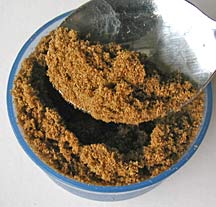|
Key Ingredient
|
Cumin
 |
The basics: Cumin, pronounced KOO-minh or KYOO-mihn, is the seed of a plant in the parsley family. It is native to Egypt with a history dating back thousands of years. Cumin seeds have been found in the pyramids and the ancient Romans and Greeks used it to treat a number of ailments.
The seedpods are dried and resemble caraway seeds. The spice has a very distinct aromatic essence that is very pungent and slightly bitter.
Cumin is broken down into three color variations, with amber being the most widely available. White and black cumin are popular throughout Asia.
The spice is cultivated in the hot climates of India, North Africa, China and South and Central America. Cumin is present in two of the most popular spice mixtures: curry and chili powder. It is also prevalent in Mediterranean as well as Middle Eastern and Spanish cuisine.
Cumin is believed to ease stomach ailments and to stimulate the appetite.
Selecting: Cumin is available whole or ground into a brownish-green powder.
Storing: As with all spices, store cumin in a cool, dark area for no more than six months. Whole cumin will last a bit longer.
Use: Cumin marries well with most lamb dishes, stewed or grilled. It is also essential to many Mexican dishes, including enchiladas and chili sauces. Portuguese sausage is spiced with cumin, as are certain cheeses, such as German Munster. Cumin is also popular in pickles. Because it is so pungent, a half teaspoon goes a long way.
Where to buy: Whole and ground cumin are available in most supermarket spice sections, moderately priced at around $5 for 1.5 ounces.
![]()
a free-lance food writer. Contact her
online through features@starbulletin.com
[News] [Business] [Features] [Sports] [Editorial] [Do It Electric!]
[Classified Ads] [Search] [Subscribe] [Info] [Letter to Editor]
[Feedback]
